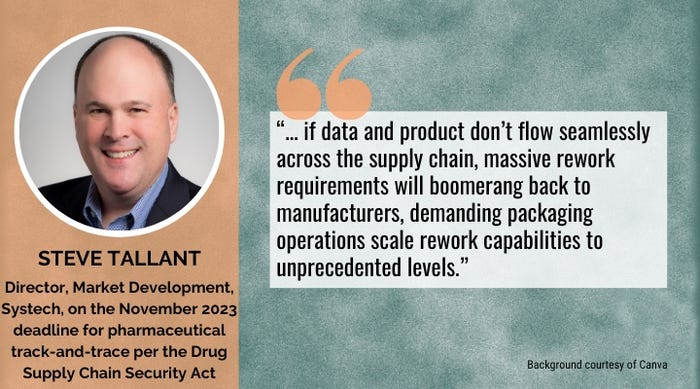Pharmaceutical Track-and-Trace Must be Perfected by November Deadline
Are you ready? Packaging operations did its DSCSA job; can the data integrations say the same?

It's go time. On November 27 of this year, the Drug Supply Chain Security Act (DSCSA) interoperability requirements take effect. Distributors must sell and accept products with a product identifier that both machines and humans can read, paired with electronic transaction information. This requires manufacturers, wholesale drug distributors, repackagers, and dispensers to exchange transaction data, including unit-level serial numbers, in a secure, interoperable, electronic manner.
Packaging stakeholders have already done plenty to comply with foundational track-and-trace regulations. But wait. There's more to be done. The Partnership for DSCSA Governance (PDG) just released new guidelines that provide insight into how DSCSA regulations will be implemented in the real world, with specific information on compliance requirements, business requirements, and functional design.
With the release of four new chapters of its Foundational Blueprint for 2023 Interoperability as of March 2023, PDG has provided the industry a clear implementation structure for its sprint to the November deadline. The Blueprint breaks down the details of serialization and interoperability. From micro to macro, these updated DSCSA guidelines lay out an industry-wide data integration reality.
Progress in packaging and serialization.
A 2022 survey conducted by the Healthcare Distribution Alliance found that 75% of manufacturers plan to send all of their DSCSA-required serialized data with shipped products by the November 2023 deadline. This plan may sound like unfinished business, but it does represent progress. By contrast, the 2021 survey found that only 45% of manufacturers sent serialized data to wholesale manufacturers.
A phased approach to compliance means that from pill to pallet, much of the heavy lifting has already happened. There’s been progress in packaging and serialization. By and large, product labels have been modified and redesigned. Packaging line systems are updated and upgraded. Physical printing of barcodes and human-readable information is aligned, and barcode grading of “C” or above has been tested with downstream trading partners.
The devil in the data details.
Data integration efforts have been in the works too. Verification Router Service (VRS) has been generally established to automate the verification of serial numbers of saleable returns. Not everyone has fully implemented VRS, but come November 27, it must be part of the plan.
While Transaction Information (TI) and Transaction Statements (TS), known as TI/TS, are now electronically exchanged at the lot level, the newly published Blueprint describes how to enable a functional data stream aligned at the product level across each stage of pharmaceutical distribution. Electronic Product Code Information Services (EPCIS) Exchange will facilitate the transfer of interoperable TI/TS data. EPCIS provides real-time visibility into the movement and location of products within the supply chain, identifying bottlenecks, tracking inventory levels, and optimizing processes.
Packaging and repackaging teams are also adopting aggregation solutions to accurately track identification and familial relationships. The DSCSA spells out serialization requirements for unit and case levels. However, before regulatory enforcement has even been triggered, wholesalers are demanding aggregation across all packaging hierarchies, ensuring serialized relationships between unique identifiers.

Even with all these preparations, there are points in the data flow where misalignments are likely to occur:
• Mismatch between barcode and human-readable data is a packaging industry concern. Inspection on the packaging line to avoid errors is key to eliminating package identification mismatch.
• As drug ownership moves from point to point in the supply chain, accompanying data must flow concurrently, delivered successfully to the next trade partner. EPCIS exchange will assist here, but data sharing between manufacturers and distributors, wholesalers, Contract Manufacturing Organizations (CMOs), and third-party logistics (3PLs), must be carefully coordinated. Data transport failures could be caused by something as simple as a misdirected email or a rejected data handshake. Even when data is received, it could be unreadable or corrupted.
• Is parent/child data compatible? As the product moves from pouch to carton to case to pallet, a lot could go wrong. The unit number might be right, but as it moves through the system, there’s a danger of mismatch at the case level.
• Product and data mismatch isn’t just today’s problem. Data must flow at scale and then remain accessible for at least the next six years, as per DSCSA guidelines.
When misalignment happens, what do you do?
Supply chain operations will never be perfect. Products get damaged, incorrectly scanned, or wind up on the wrong pallet. Data may be incorrect, misdirected, or corrupted — all leading to misalignment exceptions downstream.
Exceptions must be expected and managed. The new concern is the number of exceptions the pharma supply chain will face come November. Post-November 2023, when the physical product doesn’t match the data, it will be quarantined while awaiting a fix or returned to the manufacturer.
Given the sheer volume of prescription medicines going through the US supply chain, putting even 1% of the products in quarantine would cripple the industry on several levels. Drug manufacturers and wholesale distributors will not be able to move products and patients may find it difficult to source medicines critical to their health and wellbeing.

Today, rework operations accommodate for unacceptable products or accidental packaging disconnects. However, if data and product don’t flow seamlessly across the supply chain, massive rework requirements will boomerang back to manufacturers, demanding packaging operations scale rework capabilities to unprecedented levels.
Avoiding these pains requires total accuracy in matching the pallet and everything it carries to the electronic record sent to the wholesale distributor and accurately reconfiguring that data as the product is repackaged downstream and sent to dispensaries. If data exchange isn’t pristine throughout, the entire system is rendered unstable.
The road ahead for pharmaceutical track-and-trace.
The big test is coming. Without forethought, preparation, and testing, companies and some aspects of the supply chain may fail, and failure is not an option.
By November of this year (2023), the pharmaceutical ecosystem needs to be ready to provide data on origin, destination, and movement through the supply chain. If a product is found to be contaminated or otherwise unsafe, it is critical to be able to quickly identify all of the locations where the product was distributed so that affected products can be removed from the market. Failure to comply with product tracing regulations can result in fines, product recalls, and damage to a company’s reputation.
Proper handling of related data is essential to the future of the pharmaceutical supply chain. The goal of total alignment of data and product is in reach with the deployment of a configurable, scalable process built to meet the integration and compliance requirements of today and tomorrow.
Steve Tallant serves as Director, Market Development for Systech where he is responsible for market strategy and the identification and development of new markets.
About the Author(s)
You May Also Like




